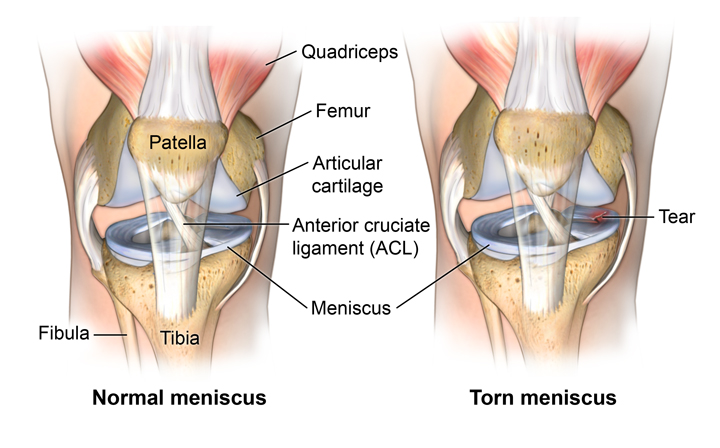Meniscal Tears
“Unlocking the Mystery of Meniscal Tears: Diagnosis and Treatment for a Common Knee Injury”

What are meniscal tears?
The menisci are C-shaped pieces of cartilage in your knee that act as shock absorbers and help to stabilise the joint. A meniscal tear is a common injury that occurs when one or both of these pieces of cartilage become damaged. Meniscal tears can be caused by a variety of things, including sports injuries, recreational injuries, and degenerative changes that occur with age. Symptoms of a meniscal tear include pain, swelling, and difficulty moving the knee. Treatment for a meniscal tear may include rest, ice, physical therapy, and in some cases, surgery.
What will you commonly feel or experience when you have a meniscal tear?
People will often have very different experiences associated with meniscal tears and the signs and symptoms will also vary depending on the type of tear you sustain, however there are some commonly overlapping symptoms and sensations which include:
- Pain: Pain is one of the most common symptoms of a meniscal tear. The pain is usually felt on the side of the knee corresponding to the tear; however, it can be felt all around the knee joint, and it may be a sharp or dull ache. The pain may be worse when twisting or bending the knee, and when going up or down stairs.
- Swelling: Swelling is another common symptom of a meniscal tear. The knee may feel swollen and stiff, and the area around the knee may be tender to the touch.
- Stiffness: The knee may feel stiff and difficult to move, especially after sitting for a long period of time.
- Locking: Sometimes, a piece of the torn meniscus can get stuck in the joint, causing the knee to “lock up” or become stuck in one position. This can make it difficult to straighten or bend the knee.
- Catching or popping: Some people may feel or hear a catching or popping sensation in the knee when they have a meniscal tear.
- Instability: A meniscal tear can cause the knee to feel unstable or like it’s going to give out, especially when walking or bearing weight on the affected knee.
It’s important to note that the symptoms of a meniscal tear can vary depending on the location and size of the tear, and not everyone with a meniscal tear will experience all of these symptoms. Some people may have a meniscal tear and not experience any symptoms at all. It’s also important to note that other knee injuries, such as ligament sprains or strains, can cause similar symptoms, so it’s important to consult with a healthcare professional for a proper diagnosis.
Are there different types of meniscal tears?
Absolutely, there are a range of tear types based on size, position and direction of the tears. It’s important to note that the location and size of the tear will affect the way it acts on the knee and the treatment options available. Some tears may be repairable, while others may require removal of the torn portion of the meniscus. A detailed examination by an orthopaedic surgeon and diagnostic imaging such as an MRI will be needed to determine the type of tear and the best course of treatment.
- Longitudinal tears: These tears occur along the length of the meniscus and are typically caused by a twisting injury.
- Radial tears: These tears occur at the outer edge of the meniscus and are typically caused by a combination of twisting and bending.
- Horizontal tears: These tears occur across the width of the meniscus and are typically caused by a combination of twisting and bending.
- Bucket-handle tears: These are the most severe type of meniscal tear, in which a segment of the meniscus is torn away from the rest of the tissue, and it can get stuck in the joint as a bucket handle.
- Complex tears: These are tears that have multiple components, and can have a combination of radial, longitudinal, and horizontal tears.
The most important distinction however, is if the meniscus tear is acute and traumatic, or if it is caused by general degeneration within the knee. This determines the likely course of management

image via : John Hopkins Medicine
What are the diagnostic steps for identifying meniscal tears?
Diagnosis of a meniscal tear typically involves a combination of a detailed history, a physical examination, and imaging tests.
- Medical history: Your doctor will ask you about your symptoms, and any previous knee injuries you may have had. They will also ask about your physical activity level and any other underlying medical conditions you may have.
- Physical examination: Your doctor or Physiotherapist will examine your knee, looking for signs of tenderness, swelling, and instability. They may also perform a series of tests, such as the McMurray test, Apley’s test, or Thessaly test, to determine if a meniscal tear is the cause of your symptoms.
- Imaging tests: X-rays and MRI are the most common imaging tests used to diagnose meniscal tears. X-rays can help to rule out other possible causes of knee pain, such as a bone fracture. An MRI uses powerful magnets and radio waves to produce detailed images of the inside of your knee, and is often the most accurate way to diagnose a meniscal tear.
Based on the examination, imaging, and medical history, your doctor will be able to determine the type and severity of meniscal tear, as well as the best course of treatment. The different types of meniscal tears can be classified based on the location, shape and size of the tear, such as: longitudinal, radial, horizontal, bucket-handle and complex tears. The diagnosis will also help the doctor to determine the best course of treatment, be it surgery or conservative management.
Are there any risk factors that can increase your chances of sustaining a meniscal tear?
There are several factors that can increase your risk of developing a meniscal tear, including:
- Age: The risk of developing a meniscal tear increases with age, especially in people over the age of 40. This is because the cartilage in your knee tends to become weaker and more susceptible to damage as you get older.
- Physical activity: People who participate in high-impact sports, such as football, soccer, and basketball, are at a higher risk of developing a meniscal tear due to the higher likelihood of these activities leading to an impaction or twisting injury.
- Previous knee injuries: If you have previously injured your knee, you may be at a higher risk of developing a meniscal tear in the future, for example if you have instability following a ligament rupture
- Structural changes in the knee: Conditions such as Osteoarthritis (OA) can cause the cartilage in your knee to change over time, increasing your risk of developing a meniscal tear.
- Obesity: Being overweight can put extra strain on your knee joints, increasing your risk of developing a meniscal tear.

When is surgery indicated?
Surgery may be recommended for a meniscal tear if conservative treatments, such as rest, ice, and physical therapy, have not been successful in relieving your symptoms. Surgery may also be recommended if your meniscal tear is causing your knee to become unstable or if it is causing your knee joint to wear down prematurely.
In some cases, a meniscal tear may be repaired, meaning the torn piece of cartilage is sewn back into place. This is more likely to be successful if the tear is relatively ‘fresh’ and the edges of the tear are still well-defined. The success of the repair also relies on a good blood supply which means that the younger the patient, the better the outcome.
If the tear is too large or the edges of the tear are frayed, the damaged portion of the meniscus may need to be removed. This is called a meniscectomy.
Your doctor will be able to determine the best treatment option for you based on the location, size, and type of your meniscal tear, as well as your age, overall health, and level of activity.
Is there benefit or evidence for PRP injections, Cortisone injections or Shock Wave treatments for meniscal tears?
There is some limited evidence to suggest that platelet-rich plasma (PRP) injections, cortisone injections, and shockwave therapy may be effective in treating meniscal tears. However, much more research is needed to fully understand the effectiveness of these treatments and recommendation of these as treatments is guarded at this stage.
What is a typical timeline for recovery?
The timeline for recovery from a meniscal tear depends on a variety of factors, including the location and severity of the tear, your age and overall health, and whether or not you have undergone surgery. In general, most people can expect to be fully recovered from a meniscal tear within 6-12 weeks.
Recovery timeline for surgical repaired meniscal tears have a similar time frame of recovery to those managed non-operatively, however you will need to avoid flexing your knee past 90 degrees for 6 weeks in most circumstances. To achieve this, you will likely be placed in a knee brace that prevents you bending past 90 degrees. Some surgeons may also stop you weight-bearing on your leg for 6 weeks. You then are able to gradually return to activities over the next 6 weeks
Recovery timeline for meniscectomy ranges from 2-6 weeks. As the problematic piece of meniscus has been removed, protection for the meniscus is not specifically required as it would be in a repair. Once the wounds are healed, you can generally commence normal activities, however it may take 6 weeks to return to high impact/labouring activities.

What should you do if you suspect you have a torn meniscus?
If you sustain a knee injury that you are concerned about, you should talk to your general practitioner or your physiotherapist as soon as possible. If you don’t already have a trusted GP or Physio to assist we are here to help and would love to assist your recovery. See below for details on what MTP Health service would be most suitable for you.
MTP’s Urgent Injury Clinic:
If you have hurt your knee in the past few days, are limited in movement and experiencing pain and swelling CLICK HERE and book into next available clinic and one of our team will contact you back to discuss. If required your oversight and consultation will be provided by our consultant Orthopaedic Knee surgeons at no additional out of pocket expense to you.
MTP Physiotherapy Consultation:
You are concerned you have torn your meniscus and you would like to make a Physio consultation to be assessed at one of our practices. CLICK HERE to find an appointment.
Still unsure what you should do? Feel free to CONTACT US and one of our team would be happy to speak with you and answer any questions you may have.
